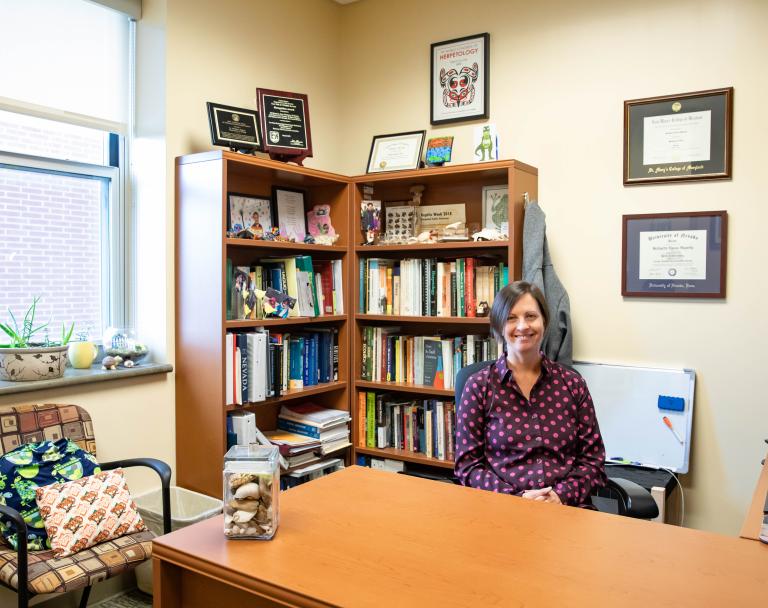Office Space: Bridgette Hagerty (Associate Professor, Department of Biology)

Office Space: Bridgette Hagerty (Associate Professor, Department of Biology)
September 27, 2022
The way a person decorates can say a lot about them. In the Office Space series, we go beyond the résumé and get to know York College faculty and staff members through the objects they like to keep close.
When you walk into Dr. Bridgette Hagerty’s office, there are two things you might notice: her children are prolific artists, and she has a deep love for nature, especially amphibians and reptiles. As an ecologist and herpetologist (scientist who studies amphibians and reptiles), she surrounds herself with memories of wild places she has had the privilege to visit for research or pleasure.
1. Peeper the Frog
One of the top conversation pieces in Dr. Hagerty’s office is a frog enclosed in a clear rectangular prism. Dr. Hagerty says, “Nine out of 10 visitors ask me if the frog is real!” Spoiler Alert – it isn’t real. If you look at it from an angle, you can see the frog’s skeleton, but from another angle it will completely disappear. “This gift from my sister is a hologram that was created with a 3-D printer. I named it Peeper because it resembles the Spring Peeper – a species of frog that I study with York College Biology majors.”
2. Daughter's embroidery
Dr. Hagerty has a framed piece of embroidery displaying the poem “Nothing Gold Can Stay” by Robert Frost. Frost is one of Dr. Hagerty’s favorite poets. Her daughter, Abby, created this artwork featuring her mom’s favorite poem, which articulates that first burst of color when leaves blossom in spring. Dr. Hagerty says, “She embroidered it for me as a Mother’s Day gift. It is one of my most treasured possessions because it was carefully designed and took many hours to complete.” This framed piece is directly adjacent to what her daughters call “the Art Wall.” She proudly displays their drawings, paintings, and crafts throughout her office.
3. Carved Turtle Collection
“I have been collecting carved turtles since I was an undergraduate,” Dr. Hagerty says. “I had an internship studying the conservation of the diamondback terrapin and from that point on I was hooked on reptiles!” Her first carved turtle was purchased for her by a college friend on a trip to Mexico. Now her collection has expanded to over 20 turtles carved from a variety of media including wood, jade, and fossiliferous limestone. Turtles are important global symbols of long life, strength, and endurance. Her collection includes turtles from Kenya, Thailand, Greece, and Peru.
4. Nature treasures and photographs
The natural world is full of wonder. While investigating local wild places, Dr. Hagerty loves to collect shells, rocks, bones, and hundreds of photographs. “The photos I have framed in my office are some of my favorite species from the Mojave Desert, where I conducted research for 10 years,” Dr. Hagerty explains. She also has a shelf packed with turtle shells, gopher skulls, and other curiosities. “Sometimes students will bring in a moth wing to ask about what species it is or to show me a photo they have taken of a toad. I love having those conversations. Nature can inspire awe in all of us if we slow down and take time to observe it.”
Dr. Bridgette Hagerty is an Associate Professor in the Department of Biology. Dr. Hagerty teaches courses on biostatistics, conservation biology, animal behavior, and a project-based course that allows students to propose real solutions to local environmental problems. Dr. Hagerty conducts research with York College students on human threats to terrestrial wildlife (including amphibians and reptiles) in York County. She has presented her research with students at the Joint Meeting of Ichthyologists and Herpetologists, the Annual Meeting of the Wildlife Society, and the Annual Meeting of the Pennsylvania Academy of Sciences. Most recently, she published an article in Chelonian Conservation and Biology.

